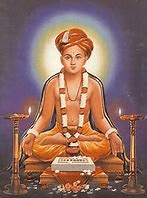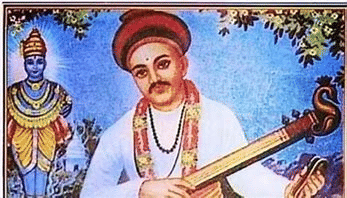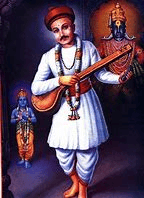The Bhakti Movement - The Religious Movements in the 15th & 16th Centuries | History for UPSC CSE PDF Download
Introduction of Bhakti Movement
The Bhakti movement was a religious reform movement during the medieval period. It taught people to directly worship God without needing a priest as an intermediary. The main goal of the Bhakti movement was to make society better by breaking down barriers of caste, religion, and gender between the devotee (bhakta) and God (bhagwan). Bhakti comes from the Sanskrit word "Bhaj," which means to serve. 'Bhakti' essentially means affection, respect, faith, love, dedication, worship, and religious devotion. The key idea of the Bhakti movement is that when someone loves and worships God, they should forget all differences and boundaries.
Main principles of Bhakti Movement
- God is one, but he can take many forms.
- Worshipping God with devotion is better than performing religious ceremonies and rituals and going on pilgrimages.
- Serving humanity is to worship God.
- All humans are equal, and all caste distinctions are meaningless.
- Superstitious practices are to be given up.
- Bhakti saints travelled to several places writing poems in vernacular languages, attracting many people under their fold.
The term Bhakti first appeared in the Vedas and was widely used in the Bhagwad-Gita by Vyasa. However, the Bhakti movement as a cultural phenomenon began later in the 6th century CE. The Bhakti movement emerged in South India between the 6th and 10th centuries CE, primarily through the verses of Alvars and Nayanars. It later spread throughout India, particularly in North and East India, via texts like Bhagavata-Purana and Bhagavad Gita. This movement reached its peak from the 14th to the 17th centuries CE.
This chapter focuses on the Bhakti saints of South and East India. The subsequent chapter will delve into the religious progressions in North India.
Causes of Bhakti Movement
- Religious factor – By around the year 1000, religion became very ritualistic and full of superstitions, with multiple gods and conflicting beliefs. The Bhakti movement promoted a simple and logical view of religion centered on love.
- Social factors – Indian society faced numerous issues like the caste system, untouchability, mistreatment of women, witchcraft, and sacrifices. Initially, untouchables and women were not allowed to perform sacrifices in the religious practices. However, the Bhakti movement welcomed everyone.
- Political factors – Prior to the Turkish conquest, alternative beliefs couldn't flourish as society was controlled by the Rajput-Brahmins. The arrival of Islamic rulers led to the loss of temple wealth and state support for the Brahmans. This allowed for opposition to Brahminical dominance and caste systems.
- Economic factors – Feudalism's rise brought in harsh revenue systems based on unfair taxes and forced labor. The Bhakti movement stood for the common people against feudal oppression.
- Influence of Sufism – Bhakti and Sufism shared similar concepts and arose as dissent against the orthodoxies within their religions.
- Solace in turbulent times – During periods of intense turmoil under certain rulers, there were incidents of temples being plundered and cities being sacked not just by foreign invaders but also by local rulers. Bhakti offered comfort to the distressed individuals in the violent society.
Bhakti movement in South India
- The Bhakti movement began in South India.
- In Tamil Nadu, two groups of Bhakti saints arose - Alvars (devotees of Vishnu) and Nayanars (devotees of Shiva).
- Alvars and Nayanars were poet-saints from Tamil Nadu who were pivotal in spreading the Bhakti Movement between the 5th and 10th centuries.

Features of Nayanars and Alvars
- They criticized Buddhists and Jains strongly.
- They welcomed people from all social classes, even those considered untouchable like Pulaiyar and Panars.
- They were inspired by ideas of love and heroism from Sangam literature.
- They preached devotion to Shiva (Nayanar) or Vishnu (Alvar) as a way to achieve salvation. They were closely associated with temple worship, often visiting Pandya and Chola temples.
- They composed poems honoring the deities worshipped in local communities. Additionally, they wrote biographies of the saints known as Alvars and Nayanars.
- Women saints also emerged among them. Notably, Andal was the sole female Alvar, while Karaikkal Ammaiyar, Mangayarkkarasiyar, and Isaignaniyaar were female Nayanars.
Growth of Bhakti Literature in the South:
Important books by Alvar Saints:
- Naalariya Divya Prabandham (Four Thousand Divine Hymns)
- Compilation of poems by 12 Alvar saints, put together by Nathamuni between the 9th and 10th centuries.
- Praises Narayana (Vishnu) and his various forms.
- Considered the 5th Veda by Alvar Saints.
- Tiruvaymoli (words of the sacred mouth)
- An 1102-verse Tamil poem created in the 9th century by Nammalvar.
- Forms part of the Divya Prabandham.
- Nammalvar sees himself as a gopi in search of Krishna.
Important books by Nayanar Saints:
- Thirumurai (holy division)
- A twelve-volume collection of hymns praising Shiva by various Tamil poets.
- Considered the 5th Veda by Shaivites.
- Thevaram
- The first seven volumes of Thirumurai.
- Compiled by Nambiyandar Nambi.
- Works of three 7th and 8th century Tamil poets: Sambandar, Appar, and Sundarar.
- Periya Puranam
- Part of Thirumurai containing life details of the 63 Nayanar saints.
- Compiled by Sekkizhar.
The Development of Vedanta
- The Vedanta philosophy is one of the six main belief systems in Hinduism.
- Other Indian philosophies are Samkhya, Yoga, Nyaya, Vaisesika, and Mimamsa.
- 'Vedanta' comes from 'Veda' and 'Anta', meaning the end part of the Vedas.
- Vedantic schools focus on wisdom, yoga, and devotion to God.
Vedantic Bhakti Schools:
Shankaracharya (8th Century CE):
 Shankaracharya
Shankaracharya
- He was a devotee of Lord Shiva and propagated the philosophy of Advaita (Non-dualism).
- His core beliefs included the idea that the ultimate reality is the oneness of the individual soul (Atman) and the Supreme God (Brahman).
- He taught that Brahman is Nirguna, meaning formless and without attributes, and that the world we perceive is an illusion, referred to as Maya.
- To understand the true nature of Brahman and attain salvation, one must renounce worldly attachments and follow the path of knowledge (Jnana yoga).
Ramanujacharya (1017-1137 CE):
 Ramanujacharya
Ramanujacharya
- A devotee of Lord Vishnu, he founded the Bhakti Marg, a new strand of Bhakti in India, and wrote the Geeta Bhasya.
- He worked for the upliftment of people with a focus on equality.
- His philosophy, Vishishta Advaita (Qualified Non-dualism), teaches that there is a qualified oneness where the soul, even when united with the Supreme God, remains distinct.
Madhavacharya (1238-1317 CE):
 Madhavacharya
Madhavacharya
- He advanced the philosophy of Dvaita (Dualism), which asserts that while a devotee can reach God, the devotee (Bhakta) and God (Bhagwan) are distinct and can never be fully unified.
- He also taught that the world is real and not an illusion.
- His concept of Tattvavada involves two categories of reality:
- Svatantra Tattva (Independent Reality), where God is the cause of the universe and the only independent reality.
- Asvatantra Tattva (Dependent Reality), which includes Jiva (individual souls) and Jada (matter).
Vallabhacharya (1479-1531 CE):
 Vallabhacharya
Vallabhacharya
- Hailing from a Telugu Brahmin family in Varanasi
- He promoted the philosophy of Shuddha Advaita (Pure Non-dualism)
- God is the universe itself, atomic in size but pervading the whole body through the essence of intelligence
- He taught that Maya is not unreal
- Everything is Krishna's Leela (divine play)
- Vallabha founded the Pushti Marg (Path of Grace)
- Rejecting asceticism and monastic life
- Believed that the soul is both an enjoyer and a doer
Nimbarka (11th Century CE):
 Nimbarka
Nimbarka
- He proposed the philosophy of Dvaita Advaita (Dualistic Monism), which involves three categories of objects: Ishwar (God), Chit (Conscious objects), and Achit (Unconscious objects).
- While Ramanuja emphasized oneness over difference, Nimbarka considered both oneness and difference to be equally important.
Chaitanya Mahaprabhu (1486-1534 CE):
 Chaitanya Mahaprabhu
Chaitanya Mahaprabhu
- He introduced the philosophy of Achintya Bheda Abheda (Inconceivable Oneness and Difference), which states that God is simultaneously one with and different from His creation.
- He founded Gaudiya Vaishnavism and composed the Shiksha-shtakam, a series of eight devotional prayers.
- His followers regard him as the combined incarnation of Radha and Krishna.
- He also popularized the chanting of the Hare Krishna Maha-mantra.
Bhakti movement in Karnataka

Virashaivism and Lingayatism
- It emerged in response to the Tamil Bhakti movement.
- Its aim was to improve Hindu society by addressing issues like mistreatment of women and exploitation of lower castes by higher castes.
- Virashaivism, a branch of Shaivism that focuses on worshiping Lord Shiva, began gaining attention around the 12th century CE with the arrival of Basavanna.
Origin of Lingayatism:
- Basavanna introduced the teachings of Virashaivism, a distinct belief system separate from Shaivism and other religions.
- After his era, Veerashaivism became known as Lingayatism because of their central practice involving the Ishtalinga or Linga (a symbol of Shiva worn on the body).
- Since the 12th century, followers of Veerashaivism have been called Lingayats due to their tradition of wearing a Linga.
The essential features of Lingayatism:
- It envisioned a society where everyone was seen as equal. It promoted an anti-pollution belief.
- Rejecting the worship of many Gods and Goddesses, it advocates against ritualistic practices.
- Shasthala ashtavaranas (six stages leading to enlightenment) and panchacharas (five conduct codes for devotees).
- The Core Trio of Lingayatism includes Basavanna (founder), Akka Mahadevi (leading female poet), and Allama Prabhu (12th-century mystic-saint and poet).
- Vachana Sahitya forms the literature of Lingayats. It comprises rhythmic Kannada writings developed in the 11th and 12th centuries as part of the Sharana movement.
- Vachanas are simple verse compositions aimed at easy memorization.
- Writers of Vachanas are referred to as Vachanakara.
- The Sharana movement emphasized attaining God-realization while addressing societal challenges.
- Over 200 individuals within the movement composed vachanas (couplets).
- Vachana poets hailed from various backgrounds: boatmen, barbers, tailors, fishermen, woodcutters, hunters, etc.
- Madara Chennaiah, an 11th-century cobbler-saint during the Western Chalukyas era, is honored as the 'father of Vachana poetry'.
Difference between Lingayats and Virashaivas

Trinity of Lingayatism
Basavanna
- Basavanna spread social awareness through his Vachana.
- He introduced a new institution known as Anubhava Mantapa (or the "hall of spiritual experience"), where individuals from all walks of life could openly discuss both worldly and spiritual matters.
- Basavanna delivered speeches condemning various societal customs like caste distinctions, astrology, temple construction, and occult practices.
Allama Prabhu
- 12th-century mystic-saint and Vachana
- Propagated the unitary consciousness of Self and Shiva.
Akka Mahadevi (1130–1160)
- Akka (elder sister) was presented by other Lingayat saints, indicating her significant role in the spiritual discussions at the "Anubhava Mantapa".
- She authored 430 Vachanapoems and two concise works, Mantrogopya.
Nathpanthis, Siddhars and Yogis
The Nathpanthis, Siddhars, and Yogis were part of religious movements that arose in the medieval period. They used clear, logical reasoning to criticize the rituals, traditions, and societal structure of traditional religions.
Beliefs of Nathpanthis, Siddhars and Yogi
- They criticised the rituals, conventional religion and the social order.
- They promoted renunciation of the world.
- These groups became popular, especially among “low” castes.
Nathpanthis
- Nath is a special group in Hinduism found in India and Nepal.
- They combined ideas from Shaivism, Buddhism, and Yoga.
- The followers of Nath are called Naths.
- The Naths are devotees who see Shiva as their main lord and have other spiritual leaders too.
- Matsyendranath, a saint and yogi from the 10th century, started the Nath tradition.
- One of his students, Gorakhnath, continued and developed the Nath tradition.
- The Nath tradition also had an impact in Bengal and Assam.
Yogis
- They thought that focusing on the formless God and understanding unity with it leads to salvation.
- The Yoga Sutras of Patanjali are considered to be put together around the 5th century CE. However, yoga as a meditative practice has been done since ancient Vedic times.
- The Yogis encouraged activities like yogasanas for rigorous mental and physical training using meditation and breathing techniques.
Siddhars
- Siddha means accomplishments. Siddhars are holy individuals who achieved success in medicine.
- Eighteen Siddhars played a role in advancing the Siddha medical system. This wisdom was transmitted through a teacher-student bond.
Saints of Maharashtra
Between 13th and 14th Century, saints from Maharashtra wrote poems in simple Marathi, inspiring people with their teachings. Shri Vitthal Rukmini Mandir in Pandharpur served as an important center for these saints, who shared the belief that a personal god resides within the hearts of individuals.
Dnyaneshwar/Janeshwar/Jnanadeva (1275–1296):
 Jnanadeva
Jnanadeva
- He was part of the Nath tradition, which considers Shiva as the first guru.
- His contributions to Marathi literature include the Dnyaneshwari, a commentary on the Gita, and Amrutanubhav.
Namdev (1270-1350):
 Namdev
Namdev
- A member of the Warkari cult, some of his hymns are included in the Guru Granth Sahib.
- He emphasized the importance of marriage and family life, teaching that these are the primary means to achieve Moksha (self-realization).
Sakkubai:
- A devotee of lord Vitthala
- Born in a Brahmin family, she faced mistreatment from her in-laws
Eknath (1533-1599):
 Eknath
Eknath
- As the spiritual successor to prominent Marathi saints like Dnyaneshwar and Namdev, he was also a member of the Warkari cult.
- His writings include the Eknathi Bhagavata, Bhavarth Ramayan, and Rukmini Swayamwar.
Sant Tukaram (17th century):
 Saint Tukaram
Saint Tukaram
- He belonged to the Warkari cult, worshipping Vithoba and advocating a duty-based approach to life.
- He rejected ritualism, outward displays of religiosity, and social distinctions, emphasizing that Bhakti is about sharing in others’ suffering.
- He also dismissed the idea of renunciation or monastic life.
Family of Chokhamela (belonged to the Warkari cult)
Chokhamela (14th century)
- He was a member of the Mahar caste and is known for his devotional poetry, Abhangas, sung in praise of the God Vitthala.
- One of his notable compositions is "Abir Gulal Udhlit Rang."
Soyarabai (Wife of Chokhamela)
- She composed her own blank verses and Abhangas.
- In her writings, she expressed her displeasure with God for the mistreatment of Untouchables and the misery of their lives.
- She often referred to herself as "Chokha's Mahari," emphasizing her identity as Chokhamela's wife.
Nirmala
- Nirmala, the younger sister of Chokhamela, wrote Abhangas that describe the injustices and inequalities she endured due to the caste system.
Conclusion
The Bhakti movement started in south India and eventually spread to cover all of India. The following article discusses the different trends in India’s religious history.
|
216 videos|855 docs|219 tests
|
FAQs on The Bhakti Movement - The Religious Movements in the 15th & 16th Centuries - History for UPSC CSE
| 1. What were the main principles of the Bhakti Movement? |  |
| 2. What were the causes of the Bhakti Movement? |  |
| 3. How did the Bhakti Movement develop in South India? |  |
| 4. Who were the Nathpanthis, Siddhars, and Yogis associated with the Bhakti Movement? |  |
| 5. Who were some of the prominent saints of Maharashtra associated with the Bhakti Movement? |  |

















